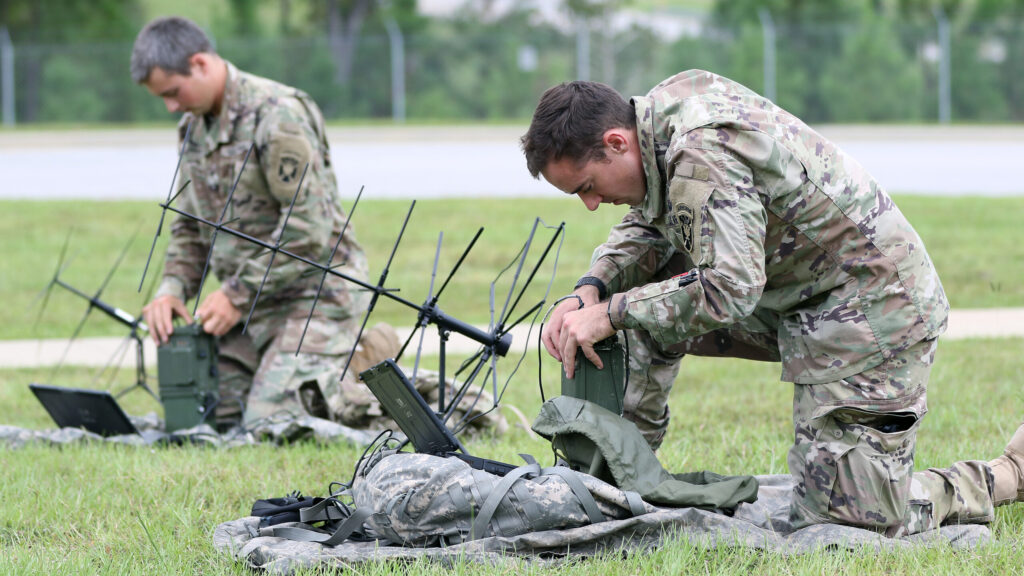
Soldiers assigned to the US Army John F. Kennedy Special Warfare Center and School practice using a PDA-184 computer and an AN/ PRC-117G satellite radio during training at the Yarborough Training Complex at Fort Bragg, North Carolina August 29, 2019. (US Army photo by K. Kassens)
WASHINGTON — The Army has contracted DRS Global Solutions and Intelsat for its long-awaited pilot program for acquiring satellite communications services — that is, buying access in the same way that individuals subscribe to a mobile phone plan.
“This is a blanket purchase agreement with an approximate $3.6 million ceiling for each of the two vendors,” Paul Mehney, director of public communications for the Army’s Program Executive Office, Command, Control, Communications-Tactical (PEO C3T), told Breaking Defense.
“It will provide commercial SATCOM subscription services, which include SATCOM coverage in different locations, terminals, bandwidth, training if required by the unit and help desk services. The goal of this pilot is to establish a managed subscription service (marketplace) that encompasses SATCOM capabilities that are currently being used in private industry. The ‘marketplace’ in essence entails a contractual vehicle for which funding can be placed to order within the scope capabilities for a period of 12 months,” he explained.
The Satellite Communications (SATCOM) as a Managed Service (SaaMS) pilot is intended to “inform decisions on the Army’s potential use of commercially leased SATCOM network services that would be flexible and tailorable to changing mission needs, versus procuring, fielding, sustaining and modernizing the equipment in house,” the Army said in an announcement today. The actual contract was awarded on Tuesday.
“A SaaMS business model could more efficiently support Soldiers in diverse locations with diverse mission challenges during large scale combat operations,” said Col. Stuart McMillan, project manager for PEO C3T’s Tactical Network, in the announcement. “A SaaMS business model could also provide for rapid tech insertions and opportunities to mitigate surge requirements.”
Mehney said that pilot is expected to start in the first quarter of fiscal year 2024 in several regions around the globe. If successful, he added, the Army intends “to open up to a multi-vendor approach so vendors that may not be part of this pilot will have an additional opportunity to compete.”
“SaaMS would not be a one-size-fits-all model,” he added, rather one that could be tailored to a “wide variety of different missions and threats.”
Further, Mehney explained, the Army doesn’t intend to hold only one event to evaluate the pilot’s success, rather “to enable operational units to use the capability to best suit their needs and roll it into their existing training events” that each will provide feedback.
Commercial SATCOM providers have long urged DoD and the services to move from buying bandwidth in fits and starts to service contracts. Major SATCOM providers — such as Hughes (a subsidiary of SATCOM giant Echostar), Viasat, Intelsat, Inmarsat, SES and Eutelsat — have argued that this would not only ease problems with service gaps that have long plagued troops in the field, but also be cheaper and allow speedier integration of new technology.
The Space Force — led by Space Systems Command’s new(ish) Commercial Space Office (COMSO), and the Space Warfighting Analysis Center — has been working to shift its acquisition strategy toward greater reliance on commercial solutions, in particular the use of SaaMS.
COMSO’s Commercial Satellite Communications Office has long bought SATCOM services from Iridium, and has served as a middleman between other SATCOM providers and military users via the Defense Information Systems Agency (DISA), with funds coming the Defense Working Capital Fund. And in July, the office worked with DISA to grant its first-ever contracts for communications services from proliferated low Earth orbit satellites to 16 providers. The five-year indefinite delivery/indefinite quantity contracts guarantee each vendor a minimum of $2,000, and puts them in the running for future task orders. The winners included DRS and Intelsat, as well as ARINC, Artel, Capella Federal, BlackSky Geospatial Solutions, Hughes Network Systems, Inmarsat Government, KGS, OneWeb Technologies, PAR Government, RiteNet Corporation, Satcom Direct Government (SDG), SpaceX, Trace Systems, and UltiSat.
Further, the Pentagon has two separate top-level strategies underway to look at how to spur commercial space integration: one spearheaded by Chief of Space Operations Gen. Chance Saltzman and Air Force Assistant Secretary for Space Acquisition and Integration Frank Calvelli, the other by the Defense Department’s Space Policy czar John Plumb. So far, however, the Space Force has been slow to shift significant funding to the use of commercial satellite services.
The Army effort thus is being watched keenly by commercial SATCOM firms, along with a similar pilot being run by the Marine Corps.
Interestingly, while the Marine Corps is going alone on its pilot, the Army chose to go through COMSO to arrange contracting via the the existing Commercial Satellite Communications (COMSATCOM) Subscription Services contract currently managed by DISA and the Defense Information Technology Contracting Organization. COMSO, however, is due to take over such contracting authority.








